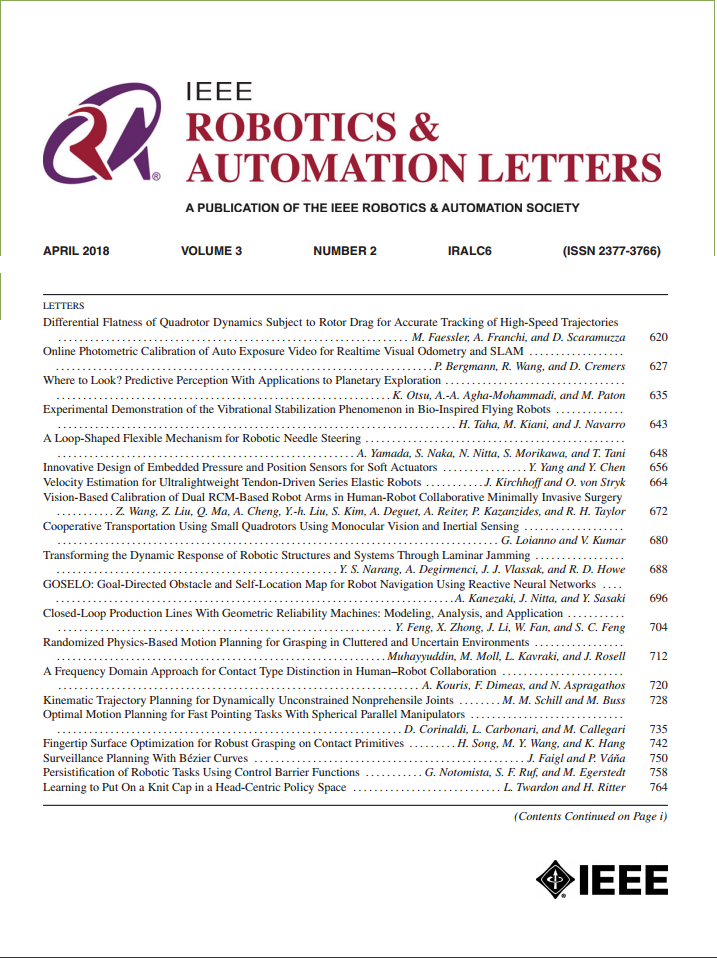Adaptive Time-Optimal Trajectory Planning Subject to Kinematic and Dynamic Constraints for Articulated Robots
IF 4.6
2区 计算机科学
Q2 ROBOTICS
引用次数: 0
Abstract
This letter proposes an adaptive time-optimal path parameterization algorithm (A-TOPP) subject to kinematic and dynamic constraints for articulated robots. The algorithm efficiently incorporates the effects of Coulomb and viscous friction, while flexibly and comprehensively addressing various kinematic and dynamic constraints in different task scenarios. It emphasizes the simultaneous management of both kinematic and dynamic constraints, ensuring versatility and high efficiency across various operational contexts. Firstly, reachable and controllable curves are generated bidirectionally based on reachability analysis. When the maximum velocity curve is exceeded, the numerical search is conducted downward to find the maximum velocity point. Subsequently, local bidirectional adaptive computations are performed to self-correct controllable and reachable curves, thereby obtaining the optimal velocity curve. Finally, the proposed method is validated using a 6-DOF robot along predetermined geometric paths. The results indicate that the A-TOPP algorithm effectively addresses the limitation of the time-optimal path parameterization approach based on reachability analysis (TOPP-RA) which only handles the single torque constraint in ideal cases. Its planning precision is nearly identical to that of the convex optimization algorithm (TOPP-CO) on different paths and remains highly consistent even under various constraints. Notably, compared to the TOPP-CO algorithm, the computational efficiency of the A-TOPP algorithm has soared dozens of times, firmly attesting to its remarkable efficacy.本文提出了一种针对铰接式机器人的、受运动学和动力学约束的自适应时间最优路径参数化算法(A-TOPP)。该算法有效地纳入了库仑摩擦和粘性摩擦的影响,同时灵活、全面地解决了不同任务场景中的各种运动学和动力学约束。它强调同时管理运动学和动力学约束,确保在各种操作环境下的通用性和高效率。首先,根据可达性分析双向生成可达曲线和可控曲线。当超过最大速度曲线时,向下进行数值搜索以找到最大速度点。随后,进行局部双向自适应计算,对可控曲线和可达曲线进行自我修正,从而获得最佳速度曲线。最后,使用一个 6-DOF 机器人沿着预定的几何路径对所提出的方法进行了验证。结果表明,A-TOPP 算法有效解决了基于可达性分析的时间最优路径参数化方法(TOPP-RA)的局限性,该方法只能在理想情况下处理单一扭矩约束。在不同路径上,其规划精度与凸优化算法(TOPP-CO)几乎相同,即使在各种约束条件下也能保持高度一致。值得注意的是,与 TOPP-CO 算法相比,A-TOPP 算法的计算效率提高了数十倍,充分证明了它的显著功效。
本文章由计算机程序翻译,如有差异,请以英文原文为准。
求助全文
约1分钟内获得全文
求助全文
来源期刊

IEEE Robotics and Automation Letters
Computer Science-Computer Science Applications
CiteScore
9.60
自引率
15.40%
发文量
1428
期刊介绍:
The scope of this journal is to publish peer-reviewed articles that provide a timely and concise account of innovative research ideas and application results, reporting significant theoretical findings and application case studies in areas of robotics and automation.
 求助内容:
求助内容: 应助结果提醒方式:
应助结果提醒方式:


